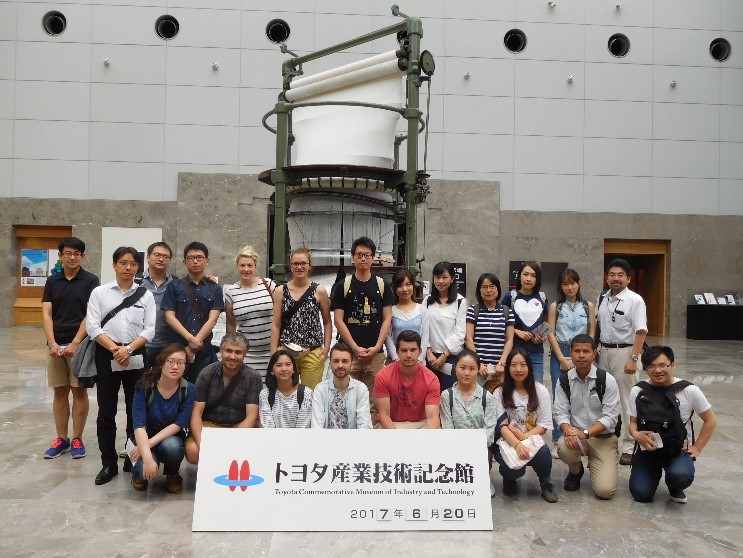What cars and cloth have in common
For the course ‘Field Research in Japan B’ a group of students from Kyoto University together with visiting students from Glasgow University travelled to the Toyota Commemorative Museum of Industry and Technology in Nagoya. When thinking of Toyota, one immediately thinks of the numerous cars Toyota creates and which are a very common sight on the streets around the world. However, when we entered the museum, we didn’t see the expected cars, but a huge circular loom.

Participants in front of the circular loom
So what is this loom doing in the museum of a large automobile company? This museum tells the story of how Toyota evolved from a maker of looms and other textile machinery to the car manufacturer it is today. Professor Kurosawa told us this transition wasn’t a coincidence. He shared his knowledge of the history of textile-machine companies, of which Toyota was one, and explained to us how development in the one sector led to an expanding skill set that could be transferred to another sector.
One thing professor Kurosawa pointed out to us was the saying of Friedrich List, who claimed that ‘cotton is the industry that makes factories’. This statement encapsulates how developments from the cotton industry could serve as an incubator for the nurturing of skills and knowledge that are required in other industries. For the production of cotton-textiles machinery, like looms and spinners, factories were necessary and to make the process more efficient all kinds of techniques were developed whose principles could also be applied to other industries. The museum showed the gradual development from the traditional spinning and weaving of cotton to the high speed machines used today.

The second stop of the field trip was at the beautiful Noritake garden where ceramics are exhibited, iconic industrial buildings are preserved and the history of the company is explained. Here, we saw the same pattern as with Toyota: technical improvements in one sector lead to improvements in another. Beautiful ceramics were displayed in the museum, where we could see people hand painting the pieces of art. However, we found ceramics had a use far beyond decoration or practical use at the dinner table. The techniques that Noritake developed are applied in other industries as well. One example for this is the grinding wheel that was designed for delicate porcelain, but has found a new destiny as an industrial grinding wheel. Other techniques developed by Noritake have been applied in the automobile, energy and medical industries.
Iconic buildings of Noritake
For the visiting students from Glasgow, the Noritake Garden offered a great opportunity to observe characteristic architecture of Japan’s industrialization era, fine ceramics and the art of Japanese gardens. By visiting these places, they could get a global idea of how Japanese industrialization compares to industrialization in Scotland.
In the end, by examining the history of a companies like Toyota and Noritake, we learned how they evolved over time and became the famous companies they are today. Their histories also serve as great illustrations of how industries are connected to each other by shared techniques and knowledge. And now we know that had it not been for the people endeavoring to make cotton cloth most efficiently, we might not have had the Toyota cars of today.
MSC student Wageningen University



